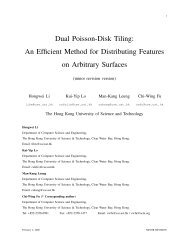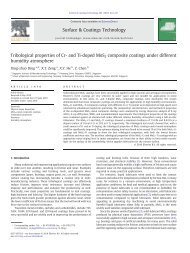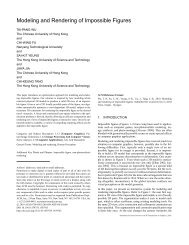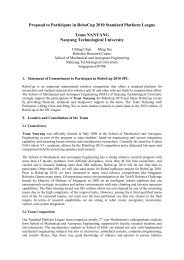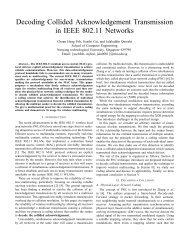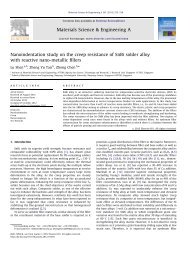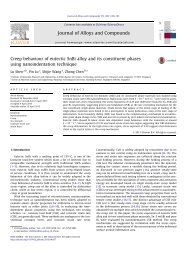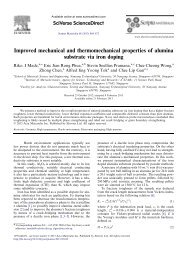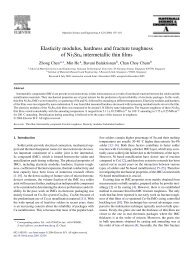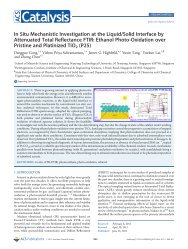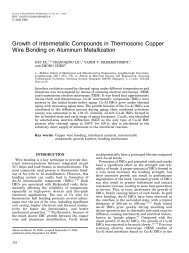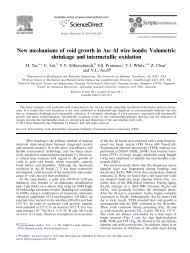Formation and migration of oxygen and zirconium vacancies in ...
Formation and migration of oxygen and zirconium vacancies in ...
Formation and migration of oxygen and zirconium vacancies in ...
You also want an ePaper? Increase the reach of your titles
YUMPU automatically turns print PDFs into web optimized ePapers that Google loves.
<strong>Formation</strong> <strong>and</strong> <strong>migration</strong> <strong>of</strong> <strong>oxygen</strong> <strong>and</strong> <strong>zirconium</strong> <strong>vacancies</strong> <strong>in</strong> cubic zirconia<br />
<strong>and</strong> <strong>zirconium</strong> oxysulfide<br />
Oleks<strong>and</strong>r I. Malyi a , P<strong>in</strong>g Wu a,b, ⁎, Vadym V. Kulish a , Kewu Bai c , Zhong Chen a, ⁎<br />
a School <strong>of</strong> Materials Science <strong>and</strong> Eng<strong>in</strong>eer<strong>in</strong>g, Nanyang Technological University, 50 Nanyang Avenue, S<strong>in</strong>gapore 639798, S<strong>in</strong>gapore<br />
b Eng<strong>in</strong>eer<strong>in</strong>g Product Development, S<strong>in</strong>gapore University <strong>of</strong> Technology <strong>and</strong> Design, 20 Dover Drive, S<strong>in</strong>gapore 138682, S<strong>in</strong>gapore<br />
c Institute <strong>of</strong> High Performance Comput<strong>in</strong>g, 1 Fusionopolis Way, 16–16 Connexis, S<strong>in</strong>gapore 138632, S<strong>in</strong>gapore<br />
article <strong>in</strong>fo<br />
Article history:<br />
Received 8 December 2011<br />
Received <strong>in</strong> revised form 20 January 2012<br />
Accepted 21 January 2012<br />
Available onl<strong>in</strong>e 24 February 2012<br />
Keywords:<br />
Vacancy<br />
Migration barrier<br />
Density functional theory<br />
Ionic conductivity<br />
1. Introduction<br />
abstract<br />
In the past decades, zirconia (ZrO2) has emerged as an important<br />
material system for gas sensors [1], high-temperature electrolysis<br />
[2], thermal barrier coat<strong>in</strong>gs [3], solid oxide fuel cells (SOFCs)<br />
[4–7], etc. For <strong>in</strong>stance, nanocrystall<strong>in</strong>e ZrO 2–CeO 2 solid solutions<br />
<strong>and</strong> Cu/CeO2/yttria doped zirconia (YDZ) are one <strong>of</strong> the most promis<strong>in</strong>g<br />
anode materials for SOFCs operat<strong>in</strong>g on hydrocarbon fuels[8,9].<br />
It is well known that three zirconia polymorphs can exist at atmospheric<br />
pressure, namely: monocl<strong>in</strong>ic (m-ZrO 2), tetragonal (t-ZrO 2)<br />
<strong>and</strong> cubic (c-ZrO2) [10–12]. In practice, it is more attractive to use<br />
oxide-doped ZrO 2 systems, s<strong>in</strong>ce addition <strong>of</strong> yttria (Y 2O 3)toZrO 2 <strong>in</strong>creases<br />
the concentration <strong>of</strong> <strong>oxygen</strong> <strong>vacancies</strong> <strong>and</strong>, consequently,<br />
significantly <strong>in</strong>creases its ionic conductivity [13–15]. Despite this, a<br />
number <strong>of</strong> recent publications report <strong>in</strong>vestigations <strong>of</strong> properties <strong>of</strong><br />
undoped zirconia polymorphs [10,12,16–29]. On the one h<strong>and</strong>,<br />
such studies can provide <strong>in</strong>formation on the chemistry <strong>of</strong> pure zirconia.<br />
On the other h<strong>and</strong>, most <strong>of</strong> the properties <strong>of</strong> yttria-doped zirconia<br />
(b40 mol% Y2O3) can generally be considered as a superposition<br />
<strong>of</strong> the properties <strong>of</strong> c-ZrO 2 <strong>and</strong> Y 4Zr 3O 12 doma<strong>in</strong>s [15,30,31], therefore<br />
such studies are the basis for underst<strong>and</strong><strong>in</strong>g <strong>of</strong> YDZ properties.<br />
S<strong>in</strong>ce defects, especially the lattice <strong>vacancies</strong>, have a major impact<br />
on the performance <strong>of</strong> the ZrO2-based devices, a lot <strong>of</strong> theoretical researches<br />
have been devoted to the <strong>in</strong>vestigation <strong>of</strong> their effects on the<br />
⁎ Correspond<strong>in</strong>g authors.<br />
E-mail addresses: wup<strong>in</strong>g@sutd.edu.sg (P. Wu), ASZChen@ntu.edu.sg (Z. Chen).<br />
0167-2738/$ – see front matter © 2012 Elsevier B.V. All rights reserved.<br />
doi:10.1016/j.ssi.2012.01.031<br />
Solid State Ionics 212 (2012) 117–122<br />
Contents lists available at SciVerse ScienceDirect<br />
Solid State Ionics<br />
journal homepage: www.elsevier.com/locate/ssi<br />
Oxygen ionic conductivity through zirconia (ZrO2) is essential to the performance <strong>of</strong> solid oxide fuel cells,<br />
thermal barrier coat<strong>in</strong>gs, <strong>and</strong> <strong>zirconium</strong> alloys for nuclear fuel cladd<strong>in</strong>g. S<strong>in</strong>ce sulfur (S) atoms can replace<br />
<strong>oxygen</strong> atoms at ZrO2 surface or even <strong>in</strong>duce formation <strong>of</strong> homogeneous <strong>zirconium</strong> oxysulfide (ZrOS) structure<br />
at high S partial pressure, we study defect <strong>migration</strong> <strong>and</strong> formation <strong>in</strong> both cubic zirconia (c-ZrO2) <strong>and</strong><br />
ZrOS under different electron <strong>and</strong> element chemical potentials us<strong>in</strong>g density functional theory. Our calculations<br />
show that S addition to zirconia, either by dop<strong>in</strong>g or through gas diffusion, <strong>in</strong>creases both the formation<br />
energy <strong>and</strong> <strong>migration</strong> barrier <strong>of</strong> doubly positively charged <strong>oxygen</strong> <strong>vacancies</strong>. S<strong>in</strong>ce the charged <strong>oxygen</strong> <strong>vacancies</strong><br />
play a vital role <strong>in</strong> the ionic <strong>and</strong> thermal conductivities, our results suggest that high S partial pressures<br />
are expected to change the mechanisms <strong>of</strong> ionic <strong>and</strong> thermal conductivities <strong>of</strong> ZrO2-based materials.<br />
© 2012 Elsevier B.V. All rights reserved.<br />
atomic <strong>and</strong> electronic structures <strong>of</strong> different zirconia phases<br />
[9,11,15–28]. Several works have also been focused on the role <strong>of</strong> <strong>oxygen</strong><br />
<strong>vacancies</strong> <strong>in</strong> the stabilization <strong>of</strong> c-ZrO2 <strong>and</strong> t-ZrO2 structures at<br />
low temperatures [14,15,30,32–36]. Nevertheless, all these studies<br />
were limited to the <strong>in</strong>vestigation <strong>of</strong> pure ZrO2 systems or ZrO2 with a<br />
low concentration <strong>of</strong> oxide additions (MgO, Y 2O 3, <strong>and</strong> CaO). In fact,<br />
doped <strong>and</strong> undoped ZrO2 as well as oxidation (corrosion) <strong>of</strong> <strong>zirconium</strong><br />
(or <strong>zirconium</strong> alloys) can be affected by environmental conditions. For<br />
<strong>in</strong>stance, at high sulfur (S) partial pressure S atoms can replace <strong>oxygen</strong><br />
atoms at ZrO 2 surface, or <strong>in</strong>duce coexistence <strong>of</strong> ZrO 2 <strong>and</strong> <strong>zirconium</strong> oxysulfide<br />
(ZrOS) structures or even formation <strong>of</strong> homogeneous ZrOS<br />
structure (P213 space group, see Fig. 1a) [28,37,38]. Hence,itbecomes<br />
clear that transition between ZrO2 <strong>and</strong> ZrOS phases can change system<br />
properties; however, no studies on this topic have been reported so far.<br />
Therefore, we report density functional theory (DFT) calculations on the<br />
<strong>migration</strong> <strong>of</strong> <strong>oxygen</strong> <strong>vacancies</strong> <strong>in</strong> c-ZrO 2 <strong>and</strong> ZrOS <strong>and</strong> on the formation<br />
<strong>of</strong> <strong>oxygen</strong> <strong>and</strong> <strong>zirconium</strong> <strong>vacancies</strong> <strong>in</strong> these structures under different<br />
electron <strong>and</strong> element chemical potentials.<br />
In this paper, undoped c-ZrO2 (Fm3m, see Fig. 1b) was chosen for<br />
the defect calculations <strong>in</strong> zirconia. It is noteworthy that formation energies<br />
<strong>of</strong> <strong>in</strong>tr<strong>in</strong>sic <strong>vacancies</strong> <strong>in</strong> cubic, tetragonal, <strong>and</strong> monocl<strong>in</strong>ic zirconia<br />
polymorphs are close to each other [21,23,24,26,27,39]. Besides, s<strong>in</strong>ce<br />
the lowest <strong>migration</strong> barrier <strong>of</strong> <strong>oxygen</strong> vacancy <strong>in</strong> YDZ corresponds to<br />
the configuration where <strong>oxygen</strong> vacancy is placed far away from yttrium<br />
ions [14,34,35,40,41], <strong>migration</strong> barrier <strong>of</strong> doubly positively charged<br />
<strong>oxygen</strong> vacancy (VO +2 )<strong>in</strong>c-ZrO2 can be directly compared with that <strong>in</strong><br />
YDZ. Therefore, our study not only enhances current underst<strong>and</strong><strong>in</strong>g <strong>of</strong><br />
sulfur poison<strong>in</strong>g <strong>of</strong> zirconia <strong>and</strong> SOFC anode materials, but also provides
118 O.I. Malyi et al. / Solid State Ionics 212 (2012) 117–122<br />
guidance for the development <strong>of</strong> new materials for gas sens<strong>in</strong>g, hightemperature<br />
electrolysis, thermal barrier coat<strong>in</strong>gs <strong>and</strong> SOFCs.<br />
2. Methodology<br />
Fig. 1. Structures <strong>of</strong> (a) ZrOS, (b) cubic ZrO2, <strong>and</strong> (c) ZrS2. The red spheres are O ions, green spheres are Zr ions, <strong>and</strong> yellow spheres are S ions.<br />
The first-pr<strong>in</strong>ciples calculations were carried out with<strong>in</strong> the DFT<br />
framework us<strong>in</strong>g Perdew-Burke-Ernzerh<strong>of</strong> (PBE) functional [42] <strong>and</strong><br />
the plane-wave pseudopotential method as implemented <strong>in</strong> the<br />
Quantum-Espresso package [43]. The ultras<strong>of</strong>t pseudopotentials [44]<br />
with 2s 2 2p 4 ,3s 2 3p 4 ,4s 2 4p 6 4d 2 5s 2 as the valence electron configurations<br />
for the <strong>oxygen</strong>, sulfur <strong>and</strong> <strong>zirconium</strong>, respectively, were used for the description<br />
<strong>of</strong> electron–ion <strong>in</strong>teractions. A Monkhorst-Pack mesh [45]<br />
with 10×10×10 k-po<strong>in</strong>t sampl<strong>in</strong>g was employed for prediction <strong>of</strong><br />
equilibrium lattice constants <strong>of</strong> c-ZrO 2, ZrOS, <strong>and</strong> ZrS 2(P-3m1, see<br />
Fig. 1c [46]) structures, while for defect calculations 4×4×4 k-po<strong>in</strong>t<br />
sampl<strong>in</strong>g was used. Before any structure relaxation <strong>and</strong> property calculation<br />
the converg<strong>in</strong>g tests were performed from which the plane–wave<br />
k<strong>in</strong>etic energy <strong>and</strong> charge density cut<strong>of</strong>fs were set as 50 Ry <strong>and</strong> 600 Ry,<br />
respectively, for all simulations reported here.<br />
Po<strong>in</strong>t defect calculations <strong>in</strong> both c-ZrO 2 <strong>and</strong> ZrOS structures were<br />
performed <strong>in</strong> supercells conta<strong>in</strong><strong>in</strong>g 96 atoms. All atoms <strong>in</strong> the supercells<br />
were relaxed without chang<strong>in</strong>g the lattice parameters by us<strong>in</strong>g the<br />
Broyden-Fletcher-Goldfarb-Shanno (BFGS) method until the maximum<br />
force on each atom was less than 0.01 eV/Å. The formation energy <strong>of</strong> a<br />
po<strong>in</strong>t defect (ΔHD,q) <strong>in</strong>chargestateq was calculated by [47]<br />
ΔH D;q E f ; μ ¼ E D;q −E H þ q E VBM þ E f þ ΔV þ μ i ð1Þ<br />
where E D,q is the total energy <strong>of</strong> the supercell conta<strong>in</strong><strong>in</strong>g the po<strong>in</strong>t defect;<br />
EH is the total energy <strong>of</strong> the perfect system. The second term describes<br />
the dependence on the Fermi level (E f)measuredfromthe<br />
valence b<strong>and</strong> edge, EVBM is a position <strong>of</strong> the valence b<strong>and</strong> maximum<br />
(VBM) <strong>in</strong> the perfect system, <strong>and</strong> ΔV aligns the VBM <strong>in</strong> the defect <strong>and</strong><br />
perfect crystal supercells. The chemical potentials <strong>of</strong> the constituents<br />
are given by the third term, where μ i can be rewritten as μ i=μ i ref +<br />
Δμi. μi ref was calculated for the reference materials <strong>in</strong>clud<strong>in</strong>g <strong>zirconium</strong><br />
(P63/mmc), sulfur (Fddd) <strong>and</strong> <strong>oxygen</strong> (isolated molecule stored <strong>in</strong> a<br />
large box with dimensions 20×20×20 Å 3 ). It should also be noted<br />
that although the f<strong>in</strong>ite supercell size may contribute <strong>in</strong>teraction between<br />
charged defect <strong>and</strong> its periodic images, we did not use Makov–<br />
Payne model [48] for the correction <strong>of</strong> the total energy <strong>of</strong> the charged<br />
systems, s<strong>in</strong>ce this model significantly overestimates the correction<br />
for image charge <strong>in</strong>teractions <strong>in</strong> zirconia [27].<br />
Calculations <strong>of</strong> <strong>migration</strong> barriers <strong>and</strong> predictions <strong>of</strong> the m<strong>in</strong>imum<br />
energy pathways <strong>of</strong> the vacancy hopp<strong>in</strong>g were carried out by us<strong>in</strong>g<br />
the nudged elastic b<strong>and</strong> (NEB) method [49,50]. Initial guesses <strong>of</strong> the vacancy<br />
<strong>migration</strong> pathways were generated by l<strong>in</strong>ear <strong>in</strong>terpolations<br />
(with n<strong>in</strong>e images) between <strong>in</strong>itial <strong>and</strong> f<strong>in</strong>al po<strong>in</strong>ts <strong>of</strong> vacancy jumps.<br />
Unlike the calculations <strong>of</strong> defect formation energies <strong>and</strong> DOS, <strong>migration</strong><br />
energies <strong>of</strong> defects are obta<strong>in</strong>ed by calculat<strong>in</strong>g the energy differences<br />
between configurations (saddle po<strong>in</strong>t <strong>and</strong> lowest energy state) which<br />
are structurally <strong>and</strong> electronically very similar. Therefore, this type <strong>of</strong><br />
calculations is less sensitive to errors, consequently, calculations <strong>of</strong> the<br />
<strong>migration</strong> barriers were performed with less number <strong>of</strong> k-po<strong>in</strong>ts<br />
(2×2×2 k-po<strong>in</strong>t sampl<strong>in</strong>g). In this work, we did not consider <strong>migration</strong><br />
<strong>of</strong> <strong>zirconium</strong> <strong>vacancies</strong> because we believe that they cannot provide<br />
conduction <strong>in</strong> ZrO2-based materials. For the <strong>oxygen</strong> <strong>vacancies</strong> our calculations<br />
have been limited to the study <strong>of</strong> the <strong>migration</strong> <strong>of</strong> V O +2 <strong>vacancies</strong>,<br />
s<strong>in</strong>ce this type <strong>of</strong> <strong>vacancies</strong> has the lowest <strong>migration</strong> barrier <strong>and</strong><br />
plays a central role <strong>in</strong> the ionic conductivity <strong>of</strong> both pure <strong>and</strong> oxidedoped<br />
zirconia [14,24].<br />
3. Results <strong>and</strong> discussion<br />
3.1. Atomic structures, stability diagram <strong>and</strong> elemental chemical potentials<br />
First, we perform analysis <strong>of</strong> c-ZrO2, ZrOS, <strong>and</strong> ZrS2 structures. On<br />
the one h<strong>and</strong>, it can provide <strong>in</strong>formation on different types <strong>of</strong> <strong>oxygen</strong><br />
<strong>vacancies</strong> exist<strong>in</strong>g <strong>in</strong> c-ZrO2 <strong>and</strong> ZrOS structures. On the other h<strong>and</strong>,<br />
<strong>in</strong> order to derive defect formation energies (ΔH D,q), the thermodynamic<br />
conditions (ΔμO, ΔμS <strong>and</strong> ΔμZr) need to be def<strong>in</strong>ed. The calculated<br />
structural parameters <strong>of</strong> c-ZrO 2, ZrOS, <strong>and</strong> ZrS 2 structures, listed <strong>in</strong><br />
Table 1, agree well with experimental data, but show the small consistent<br />
overestimations common for GGA. Unlike m-ZrO 2, where<br />
two types <strong>of</strong> <strong>oxygen</strong> atoms exist (fourfold <strong>and</strong> threefold coord<strong>in</strong>ated <strong>oxygen</strong>)<br />
[23], only one type <strong>of</strong> <strong>oxygen</strong> ions exists <strong>in</strong> c-ZrO2 <strong>and</strong> ZrOS structures<br />
(for more details see [16,37]). The predicted b<strong>and</strong> gap <strong>of</strong> c-ZrO2 is<br />
3.3 eV, it is smaller than the experimental values (5.4 eV - 5.7 eV) [51],<br />
but agrees with other first-pr<strong>in</strong>ciples studies [21,26–28,39,52,53]. For<br />
ZrOS structure the predicted b<strong>and</strong> gap is 2.5 eV, which also agrees well<br />
with that calculated by us<strong>in</strong>g Wien2k s<strong>of</strong>tware.[28]<br />
Predictions <strong>of</strong> the thermodynamic conditions (ΔμO, ΔμS,<strong>and</strong>ΔμZr)were<br />
carried out by us<strong>in</strong>g well def<strong>in</strong>ed methodology [10,21,26,27,47,54–57].For<br />
c-ZrO2 at the thermodynamic equilibrium (at the low sulfur partial pressure),<br />
its chemical potential can be calculated from<br />
μ ¼ μ с−ZrO2 bulk<br />
Zr þ 2μgas O þ ΔHc−ZrO2 where ΔHc-ZrO 2 is the formation heat <strong>of</strong> c-ZrO2 calculated from DFT calculations<br />
(<strong>in</strong> this work ΔH c-ZrO2 =−11.97 eV). In addition, to suspend the<br />
Table 1<br />
Lattice parameters (<strong>in</strong> Å) <strong>and</strong> formation heats (<strong>in</strong> eV) for c-ZrO2, ZrOS <strong>and</strong> ZrS2. Present<br />
results are compared with experimental data.<br />
Lattice parameters (<strong>in</strong> Å) <strong>Formation</strong> energies (<strong>in</strong> eV)<br />
This work Experiment This work Experiment<br />
c-ZrO2 5.106 5.090[16] −11.97 −11.12[62]<br />
ZrOS 5.719 5.696[37] −8.55 −7.88[62]<br />
ZrS2 3.680 3.662[46] −4.70 -<br />
5.858 5.826[46]<br />
ð2Þ
formation <strong>of</strong> bulk <strong>zirconium</strong> <strong>and</strong> <strong>oxygen</strong> gas condition (3) has to be conserved<br />
(otherwise the oxide is unstable).<br />
ΔμZr ¼ μZr−μ bulk<br />
Zr ≤ 0<strong>and</strong>ΔμO ¼ μO−EO gas =2≤0 ð3Þ<br />
For the thermodynamically stable ZrOS, the variations <strong>of</strong> elemental<br />
chemical potentials (Δμ i) are restricted by Eq.(4) <strong>and</strong> formation <strong>of</strong><br />
compet<strong>in</strong>g phases such as c-ZrO2 or ZrS2 accord<strong>in</strong>g to Eqs. (5), (6)<br />
ΔH ZrOS ¼ Δμ Zr þ Δμ O þ Δμ S<br />
ΔH с−ZrO2 ¼ Δμ Zr þ 2Δμ O ð5Þ<br />
ΔH ZrS2 ¼ Δμ Zr þ 2Δμ S ð6Þ<br />
where ΔHZrOS, <strong>and</strong> ΔHZrS 2 are calculated formation heats <strong>of</strong> ZrOS<br />
(−8.55 eV), <strong>and</strong> ZrS 2 (−4.70 eV), respectively. These conditions determ<strong>in</strong>e<br />
the phase diagram shown <strong>in</strong> Fig. 2. It can be seen that<br />
undoped zirconia is thermodynamically stable over a wide range <strong>of</strong><br />
chemical potentials. However, the comb<strong>in</strong>ation <strong>of</strong> low <strong>oxygen</strong> <strong>and</strong><br />
high sulfur partial pressures may result <strong>in</strong> the stabilization <strong>of</strong> ZrOS.<br />
In Fig. 2 the gray shaded area represents the chemical stability<br />
range <strong>of</strong> ZrOS. It should be noted that l<strong>in</strong>e through po<strong>in</strong>ts C <strong>and</strong> D<br />
(calculated by us<strong>in</strong>g Eqs. 4 <strong>and</strong> 6) corresponds to coexistence conditions<br />
<strong>of</strong> ZrOS <strong>and</strong> ZrS 2 structures. Whereas, l<strong>in</strong>e through po<strong>in</strong>ts A<br />
<strong>and</strong> B (calculated by us<strong>in</strong>g Eqs. 4, <strong>and</strong> 5) corresponds to the coexistence<br />
conditions <strong>of</strong> c-ZrO 2 <strong>and</strong> ZrOS structures. Based on these results,<br />
the defect calculations have been performed for two extreme<br />
conditions: <strong>oxygen</strong>-rich limit (po<strong>in</strong>t A, ΔμO=−3.42 eV) <strong>and</strong><br />
<strong>oxygen</strong>-poor limit (po<strong>in</strong>t B, ΔμO=−5.99 eV). This range <strong>of</strong> <strong>oxygen</strong><br />
chemical potential (ΔμO) is different from that for c-ZrO2 at low sulfur<br />
partial pressure (0 eV>ΔμO >Hc-ZrO 2 /2), therefore our results under<br />
<strong>oxygen</strong>-rich limit cannot be compared with previously reported data.<br />
3.2. <strong>Formation</strong> <strong>of</strong> <strong>zirconium</strong> <strong>and</strong> <strong>oxygen</strong> <strong>vacancies</strong> <strong>in</strong> ZrOS<br />
<strong>and</strong> c-ZrO 2 structures<br />
Details <strong>of</strong> the atomistic displacements (with reference to the perfect<br />
crystals) surround<strong>in</strong>g different <strong>vacancies</strong> <strong>in</strong> both bulk c-ZrO2 <strong>and</strong><br />
ZrOS are shown <strong>in</strong> Table 2, where NN Zr (NN O, <strong>and</strong> NN S) is the<br />
Fig. 2. Stability diagram for ZrOS as determ<strong>in</strong>ed from DFT calculations. The area conf<strong>in</strong>ed<br />
between po<strong>in</strong>ts A (Δμ O=−3.42 eV, Δμ Zr=−5.13 eV, Δμ S=0 eV), B(Δμ O=<br />
−5.99 eV, Δμ Zr=0 eV, Δμ S=−2.56 eV), C (Δμ O=−6.20 eV, Δμ Zr =0 eV, Δμ S=<br />
−2.35 eV), <strong>and</strong> D (ΔμO=−3.75 eV, ΔμZr=−4.70 eV, ΔμS=0 eV) is the chemical stability<br />
range <strong>of</strong> ZrOS. The l<strong>in</strong>e through po<strong>in</strong>ts C <strong>and</strong> B corresponds to the maximally<br />
<strong>zirconium</strong>-rich conditions (Δμ Zr=0 eV). Along l<strong>in</strong>es parallel to C–B the <strong>zirconium</strong><br />
chemical potential is constant.<br />
2<br />
O.I. Malyi et al. / Solid State Ionics 212 (2012) 117–122<br />
ð4Þ<br />
Table 2<br />
Structure relaxation <strong>of</strong> ions neighbor<strong>in</strong>g the vacancy site (only <strong>in</strong>formation for nearest<br />
neighbors (NN) is shown)(‘−’/‘+’ means <strong>in</strong>ward/outward displacement to the vacancy).<br />
VO 0<br />
VO +1<br />
VO +2<br />
VZr<br />
0<br />
− 1<br />
VZr<br />
− 2<br />
VZr<br />
− 3<br />
VZr<br />
− 4<br />
VZr<br />
For ZrO 2<br />
NN O −0.083 −0.251 −0.241 0.141 0.146 0.153 0.157 0.163<br />
NN Zr −0.028 0.194 0.196 −0.068 −0.075 −0.077 −0.082 −0.084<br />
For ZrOS<br />
NNO 0.028 0.044 0.064 0.138 0.133 0.127 0.123 0.120<br />
NNZr 0.044 0.174 0.322 −0.050 −0.054 −0.059 −0.066 −0.086<br />
NNS −0.108 −0.166 −0.282 −0.006 0.013 0.020 0.036 0.078<br />
displacements <strong>of</strong> the <strong>zirconium</strong> (<strong>oxygen</strong>, <strong>and</strong> sulfur) atoms occupy<strong>in</strong>g<br />
the nearest-neighbor (NN) sites to the vacancy. For c-ZrO 2, it is<br />
shown that formation <strong>of</strong> the neutral <strong>oxygen</strong> vacancy (VO 0 ) causes<br />
small (0.083 Å for O, <strong>and</strong> 0.028 Å for Zr) <strong>in</strong>ward displacements <strong>of</strong><br />
the neighbor<strong>in</strong>g <strong>zirconium</strong> <strong>and</strong> <strong>oxygen</strong> ions. Whereas, for positively<br />
charged <strong>oxygen</strong> <strong>vacancies</strong> (V O +1 , <strong>and</strong> VO +2 ) the Zr ions near the vacancy<br />
displace outwards by 0.194–0.196 Å, this strong relaxation is<br />
caused by the fact that the neighbor<strong>in</strong>g Zr ions lose part <strong>of</strong> the screen-<br />
<strong>in</strong>g effect provided by electrons <strong>in</strong> the neutral vacancy case. Forma-<br />
0<br />
tion <strong>of</strong> neutral <strong>zirconium</strong> vacancy (VZr) results <strong>in</strong> the repulsion felt<br />
by the <strong>oxygen</strong> ions <strong>and</strong> strong outward displacement (0.141 Å) <strong>of</strong><br />
the neighbor<strong>in</strong>g <strong>oxygen</strong> ions. These results agree well with those<br />
reported for m-ZrO2.[23] For ZrOS, the directions <strong>of</strong> atomistic displacement<br />
are the same with those for c-ZrO2, but the absolute values<br />
<strong>of</strong> displacements are somewhat different. For <strong>in</strong>stance, for VO +2 <strong>in</strong><br />
ZrOS Zr ions surround<strong>in</strong>g the vacancy displace outwards by 0.322 Å,<br />
which is 0.126 Å higher than that for c-ZrO2.<br />
The formation energies <strong>of</strong> <strong>oxygen</strong> <strong>and</strong> <strong>zirconium</strong> <strong>vacancies</strong> <strong>in</strong> c-<br />
ZrO2 <strong>and</strong> ZrOS structures for two limit<strong>in</strong>g values <strong>of</strong> <strong>oxygen</strong> chemical<br />
potentials (<strong>oxygen</strong>-rich limit (ΔμO=−3.42 eV) <strong>and</strong> <strong>oxygen</strong>-poor<br />
limit (ΔμO=−5.99 eV)) are shown <strong>in</strong> two forms: 1) at VBM (Ef=0)<br />
(see Table 3); 2) as a function <strong>of</strong> the Fermi level (Ef) (see Fig. 3). In<br />
Fig. 3 the lowest limit <strong>of</strong> the Fermi level (Ef) represents the VBM,<br />
whereas the upper limit <strong>of</strong> Ef corresponds to the bottom <strong>of</strong> the calculated<br />
conduction b<strong>and</strong> (BCCB). Only the <strong>vacancies</strong> among the lowest<br />
formation energies are shown. Due to the large formation heats <strong>of</strong><br />
c-ZrO2 <strong>and</strong> ZrOS structures defect formation energies strongly vary<br />
between the po<strong>in</strong>ts A <strong>and</strong> B <strong>of</strong> the phase diagram (see Fig. 3). In<br />
both systems defect formation energies (ΔHD,q) become negative at<br />
some Ef which determ<strong>in</strong>es p<strong>in</strong>n<strong>in</strong>g energy(εp<strong>in</strong>) [58].<br />
Next we analyze stability <strong>of</strong> <strong>oxygen</strong> <strong>and</strong> <strong>zirconium</strong> <strong>vacancies</strong> <strong>in</strong><br />
c-ZrO2. For <strong>oxygen</strong>-poor conditions, <strong>oxygen</strong> vacancy <strong>in</strong> doubly positively<br />
+2 +<br />
charged state (VO )isstableatEfbεp<strong>in</strong>. While <strong>in</strong>crease <strong>of</strong> the Fermi<br />
level (Ef) to BCCB makes neutral <strong>oxygen</strong> vacancy the dom<strong>in</strong>ant defect.<br />
For these conditions formation <strong>of</strong> <strong>zirconium</strong> <strong>vacancies</strong> is unlikely due<br />
to high defect formation energy. Increas<strong>in</strong>g the <strong>oxygen</strong> chemical potential<br />
reduces the stability <strong>of</strong> <strong>oxygen</strong> <strong>vacancies</strong> (<strong>in</strong>creases their formation<br />
energy) <strong>and</strong> <strong>in</strong>creases stability <strong>of</strong> <strong>zirconium</strong> <strong>vacancies</strong> (decreases their<br />
+2<br />
formation energies): VO still can form spontaneously near VBM, but<br />
-<br />
) <strong>zirconium</strong> <strong>vacancies</strong> (VZr −4 )aresta-<br />
for the higher Fermi level (Ef>εp<strong>in</strong><br />
ble. It should also be noted that <strong>oxygen</strong> <strong>vacancies</strong> <strong>in</strong> c-ZrO2 show a “negative-U”<br />
behavior, <strong>in</strong> other words, VO +1<br />
is not stable aga<strong>in</strong>st<br />
disproportionation <strong>in</strong>to V O <strong>and</strong> V O +2 . For ZrOS structure, VO +2 is also<br />
the most stable type <strong>of</strong> <strong>vacancies</strong> at VBM (see Table 3), <strong>and</strong> it can spontaneously<br />
form under <strong>oxygen</strong>-poor conditions (see Fig. 3). But, under<br />
<strong>oxygen</strong>-poor limit VO +1 is stable <strong>in</strong> ZrOS structure at 0.46 eV≥<br />
E f≥1.50 eV, while <strong>in</strong> c-ZrO 2 it is the metastable defect (see Fig. 3b).<br />
This suggests that the “negative-U” behavior is not typical for <strong>oxygen</strong><br />
<strong>vacancies</strong> (V O 0 ,VO +1 , <strong>and</strong> VO +2 ) <strong>in</strong> ZrOS. Similar to the c-ZrO2, <strong>in</strong>creas<strong>in</strong>g<br />
the <strong>oxygen</strong> chemical potential can make VZr −4 stable close to BCCB. Analysis<br />
<strong>of</strong> Fig. 3 can also provide some <strong>in</strong>formation on the nature <strong>of</strong> <strong>oxygen</strong><br />
<strong>and</strong> <strong>zirconium</strong> <strong>vacancies</strong> <strong>in</strong> c-ZrO2 <strong>and</strong> ZrOS structures. For both structures,<br />
formation energy <strong>of</strong> <strong>oxygen</strong> <strong>vacancies</strong> <strong>in</strong>creases with <strong>in</strong>creas<strong>in</strong>g<br />
119
120 O.I. Malyi et al. / Solid State Ionics 212 (2012) 117–122<br />
Table 3<br />
<strong>Formation</strong> energies (ΔH D,q) <strong>of</strong> <strong>oxygen</strong> <strong>and</strong> <strong>zirconium</strong> <strong>vacancies</strong> <strong>in</strong> c-ZrO 2 <strong>and</strong> ZrOS at <strong>oxygen</strong>-rich <strong>oxygen</strong>-poor limits at valence b<strong>and</strong> maximum (E f=0).<br />
Defect Charge <strong>of</strong><br />
defect<br />
VO 0<br />
VO +1<br />
+2<br />
VO 0<br />
VZr − 1<br />
VZr − 2<br />
VZr − 3<br />
VZr − 4<br />
VZr Ef <strong>in</strong>dicat<strong>in</strong>g that the <strong>oxygen</strong> <strong>vacancies</strong> behave as donors mak<strong>in</strong>g them<br />
likely compensat<strong>in</strong>g centers <strong>in</strong> the case <strong>of</strong> acceptor dop<strong>in</strong>g. Whereas,<br />
formation energy <strong>of</strong> <strong>zirconium</strong> <strong>vacancies</strong> decreases with <strong>in</strong>creas<strong>in</strong>g<br />
the Fermi level (E f) suggest<strong>in</strong>g that V Zr −4 <strong>vacancies</strong> act as acceptors <strong>and</strong><br />
play a vital role <strong>in</strong> donor compensation.<br />
To underst<strong>and</strong> how ZrO 2-ZrOS phase transition can change the<br />
stability <strong>of</strong> <strong>oxygen</strong> <strong>and</strong> <strong>zirconium</strong> <strong>vacancies</strong>, we compare formation<br />
energies <strong>of</strong> these defects <strong>in</strong> c-ZrO 2 <strong>and</strong> ZrOS structures. <strong>Formation</strong> energy<br />
<strong>of</strong> neutral <strong>oxygen</strong> <strong>vacancies</strong> <strong>in</strong> both structures are with<strong>in</strong> 0.04 eV<br />
<strong>of</strong> each other <strong>in</strong>dicat<strong>in</strong>g that ZrO 2-ZrOS phase transition hardly<br />
changes the stability <strong>of</strong> neutral <strong>oxygen</strong> <strong>vacancies</strong>. However, formation<br />
energy <strong>of</strong> V O +2 <strong>vacancies</strong> <strong>in</strong> ZrOS is 3.80 eV higher than that <strong>in</strong><br />
ΔHD,q <strong>in</strong> c-ZrO2(eV) ΔHD,q <strong>in</strong> ZrOS (eV)<br />
po<strong>in</strong>t A po<strong>in</strong>t B ref [26] po<strong>in</strong>t A po<strong>in</strong>t B<br />
ΔμO=−3.42 eV ΔμO=−5.99 eV ΔμO=ΔH c-ZrO2 /2 ΔμO =−3.42 eV ΔμO=−5.99 eV<br />
ΔμZr=−5.13 eV ΔμZr=0 eV ΔμZr=0 eV ΔμZr =−5.13 eV ΔμZr=0 eV<br />
ΔμS =0 eV ΔμS=−2.56 eV ΔμS =0 eV ΔμS=−2.56 eV<br />
0 3.16 0.59 0.50 3.12 0.55<br />
+1 0.11 −2.46 −2.46 1.07 −1.50<br />
+2 −3.19 −5.76 −5.26 0.61 −1.96<br />
0 11.00 16.14 16.00 7.35 12.49<br />
−1 10.98 16.12 15.77 7.34 12.48<br />
−2 10.89 16.03 15.74 8.36 13.50<br />
−3 11.05 16.19 15.85 7.04 12.18<br />
−4 11.34 16.48 16.02 6.23 11.37<br />
c-ZrO2. Therefore, spontaneous formation <strong>of</strong> <strong>oxygen</strong> <strong>vacancies</strong> <strong>in</strong><br />
ZrOS is unlikely under <strong>oxygen</strong>-rich conditions (see Fig. 3a). In contrast,<br />
s<strong>in</strong>ce Zr–S bonds are weaker than Zr-O bonds (this is even<br />
clear from the comparisons <strong>of</strong> formation heats <strong>of</strong> ZrS2 <strong>and</strong> c-ZrO2), formation energies <strong>of</strong> <strong>zirconium</strong> <strong>vacancies</strong> <strong>in</strong> ZrOS are significantly<br />
smaller than that for c-ZrO2 (see Fig. 3 <strong>and</strong> Table 3). For <strong>in</strong>stance, at<br />
the <strong>oxygen</strong>-poor limit formation energy <strong>of</strong> VZr<br />
0 is 12.49 eV, while<br />
for c-ZrO2 it is 16.14 eV. S<strong>in</strong>ce formation energy <strong>of</strong> the charged<br />
<strong>oxygen</strong> <strong>vacancies</strong> <strong>in</strong> c-ZrO2 is lower than that for ZrOS, it is clear<br />
that equilibrium concentration <strong>of</strong> charged <strong>oxygen</strong> <strong>vacancies</strong> <strong>in</strong><br />
c-ZrO2 is higher than that <strong>in</strong> ZrOS, while population <strong>of</strong> Zr <strong>vacancies</strong><br />
<strong>in</strong> c-ZrO2 structure is lower than <strong>in</strong> ZrOS. Fig. 3 also suggests that<br />
Fig. 3. Calculated formation energies <strong>of</strong> <strong>oxygen</strong> <strong>and</strong> <strong>zirconium</strong> <strong>vacancies</strong> <strong>in</strong> c-ZrO2 <strong>and</strong> ZrOS as a function <strong>of</strong> the Fermi level (Ef) under (a) <strong>oxygen</strong>-rich limit (ΔμO=−3.43 eV) <strong>and</strong> (b)<br />
<strong>oxygen</strong>-poor limit (Δμ O=−5.99 eV). Only the <strong>vacancies</strong> among the lowest formation energies are shown. The zero <strong>of</strong> the E f is set to the top <strong>of</strong> the valence b<strong>and</strong> <strong>and</strong> its upper limit is<br />
the m<strong>in</strong>imum <strong>of</strong> conduction b<strong>and</strong> (E C). The changes <strong>in</strong> slope <strong>in</strong>dicate a transition between charge states. P<strong>in</strong>n<strong>in</strong>g energy (ε p<strong>in</strong>)isE f at which the vacancy formation energy changes its sign.
Fig. 4. a) Oxygen vacancy hopp<strong>in</strong>g along b100>(red color direction, Path 1),<br />
b110>(green color direction, Path 2) <strong>and</strong> b111>(blue color direction, Path 3) directions<br />
<strong>in</strong> c-ZrO 2; b) Oxygen vacancy hopp<strong>in</strong>g along Path 1 (red color direction) <strong>and</strong> Path 2 (green<br />
color direction) directions <strong>in</strong> ZrOS. The red spheres are O ions, green spheres are Zr ions<br />
<strong>and</strong> yellow spheres are S ions. White spheres are <strong>oxygen</strong> <strong>vacancies</strong>.<br />
different types <strong>of</strong> <strong>vacancies</strong> can be stable at different range <strong>of</strong> Fermi<br />
level (Ef). However, Ef is not a free parameter <strong>and</strong> can be determ<strong>in</strong>ed<br />
by the condition <strong>of</strong> charge neutrality (see Eq. 7, <strong>in</strong> other words,<br />
charged defects should compensate each other or should be compensated<br />
by dop<strong>in</strong>g)<br />
∑ i<br />
q iC i ¼ 0 ð7Þ<br />
where C is a defect concentration that is related to defect formation<br />
energy (ΔH D,q) through the equation<br />
0<br />
1<br />
ΔHD;q Ef ; μ<br />
C Ef ; μ; T ¼ N exp@<br />
A ð8Þ<br />
kBT where N is a concentration <strong>of</strong> possible defect sites; T is temperature, kB<br />
is the Boltzmann constant.<br />
3.3. Migration <strong>of</strong> <strong>oxygen</strong> <strong>vacancies</strong> <strong>in</strong> ZrOS <strong>and</strong> c-ZrO 2 structures<br />
Ionic conductivity (σ) <strong>of</strong> materials depends on defect concentration,<br />
defect formation energy (ΔHD,q), <strong>and</strong> <strong>migration</strong> barrier (Em). It can be<br />
O.I. Malyi et al. / Solid State Ionics 212 (2012) 117–122<br />
expressed as an exponential function <strong>of</strong> the activation energy for defect<br />
diffusion (E a) accord<strong>in</strong>g to [59]<br />
σ ¼ σ 0=T exp − E a<br />
k BT<br />
where σ0 is a temperature-<strong>in</strong>dependent prefactor. For low concentration<br />
<strong>of</strong> <strong>oxygen</strong> <strong>vacancies</strong> the activation energy is equal to the<br />
sum <strong>of</strong> the defect formation energy <strong>and</strong> the <strong>migration</strong> barrier<br />
(E a=ΔH D,q+E m).<br />
Next, we compare <strong>migration</strong> barriers <strong>of</strong> doubly positively <strong>oxygen</strong><br />
<strong>vacancies</strong> (V O +2 ) <strong>in</strong> c-ZrO2 <strong>and</strong> ZrOS. For undoped c-ZrO 2, three possible<br />
<strong>migration</strong> pathways <strong>of</strong> <strong>oxygen</strong> vacancy exist (see Fig. 4a): <strong>oxygen</strong><br />
vacancy hopp<strong>in</strong>g along b100> (Path 1), b110> (Path 2), <strong>and</strong><br />
b111>(Path 3) directions. For Path 1, <strong>oxygen</strong> ion (vacancy) pass<strong>in</strong>g<br />
through a dumbbell <strong>of</strong> two <strong>zirconium</strong> cations <strong>in</strong> the middle <strong>of</strong> two<br />
tetrahedral <strong>oxygen</strong> sites. Analysis <strong>of</strong> the configuration for the saddle<br />
po<strong>in</strong>t (see Fig. 5) suggests that <strong>in</strong>ter-atomic distance between the<br />
hopp<strong>in</strong>g <strong>oxygen</strong> ion <strong>and</strong> the <strong>zirconium</strong> ions is 1.967 Å (for c-ZrO2<br />
the equilibrium Zr-O is 2.211 Å), therefore for Path 1 <strong>migration</strong> barrier<br />
is determ<strong>in</strong>ed by strong Coulombic attraction <strong>and</strong> large steric repulsion.<br />
Whereas, when <strong>oxygen</strong> ion hops via cation-anion pair (Path<br />
2) or large <strong>in</strong>terstitial space (Path 3), local electrostatic repulsion by<br />
surround<strong>in</strong>g anions leads to an <strong>in</strong>crease <strong>in</strong> the <strong>migration</strong> barrier <strong>of</strong><br />
the <strong>oxygen</strong> vacancy. Therefore, the lowest <strong>migration</strong> barrier <strong>of</strong> VO +2<br />
(0.282 eV) corresponds to Path 1 (see Fig. 5a). For the other pathways<br />
the VO +2 <strong>migration</strong> barriers are significantly higher (see Table 4).<br />
These results agree well with the results predicted for CeO2[60],<br />
where it has been predicted that Path 1 has the lowest <strong>migration</strong> barrier.<br />
The lowest <strong>migration</strong> barrier predicted for c-ZrO2 is with<strong>in</strong><br />
0.05 eV <strong>of</strong> that for t-ZrO 2[14].<br />
For ZrOS, also several paths for the <strong>migration</strong> <strong>of</strong> <strong>oxygen</strong> ion exist<br />
(see Fig. 4b), however <strong>in</strong> all cases the <strong>oxygen</strong> vacancy migrates not<br />
through the Zr–Zr cation pair (which is the case for c-ZrO2). Instead,<br />
it goes through the Zr–S pair (or even S-S pair). Therefore the lowest<br />
VO +2 <strong>migration</strong> barrier (3.896 eV) is significantly higher than that for<br />
c-ZrO 2 (see Fig. 5b). Because <strong>of</strong> this <strong>and</strong> s<strong>in</strong>ce equilibrium concentration<br />
<strong>of</strong> the charged <strong>oxygen</strong> <strong>vacancies</strong> <strong>in</strong> ZrOS is lower than that for<br />
c-ZrO 2, it becomes obvious that transition between ZrO 2 <strong>and</strong> ZrOS<br />
structures is accompanied by a decrease <strong>of</strong> the <strong>oxygen</strong> ionic conductivity.<br />
Moreover, it is well known that <strong>oxygen</strong> <strong>vacancies</strong> provide phonon<br />
scatter<strong>in</strong>g <strong>in</strong> ZrO2-based materials [3,61], which is necessary for<br />
Fig. 5. Energy pr<strong>of</strong>iles dur<strong>in</strong>g <strong>migration</strong> <strong>of</strong> doubly positively charged <strong>oxygen</strong> <strong>vacancies</strong> between two <strong>oxygen</strong> sites (a) <strong>in</strong> c-ZrO2 <strong>and</strong> (b) <strong>in</strong> ZrOS, horizontal axis refers to projected<br />
<strong>migration</strong> distance. Initial <strong>and</strong> f<strong>in</strong>al positions <strong>of</strong> <strong>oxygen</strong> vacancy are referred as 0 <strong>and</strong> 1, respectively. Only pathways for the lowest <strong>migration</strong> barriers (Path 1 (see Fig. 4 for both<br />
c-ZrO 2 <strong>and</strong> ZrOS)) are shown.<br />
121<br />
ð9Þ
122 O.I. Malyi et al. / Solid State Ionics 212 (2012) 117–122<br />
Table 4<br />
Calculated barriers (<strong>in</strong> eV) for the <strong>migration</strong> <strong>of</strong> doubly positively charged <strong>oxygen</strong> <strong>vacancies</strong><br />
between different <strong>oxygen</strong> sites <strong>in</strong> pure c-ZrO 2 <strong>and</strong> ZrOS.<br />
Structure Diffusion/<strong>migration</strong> barriers (<strong>in</strong> eV)<br />
Path 1 Path 2 Path 3<br />
c-ZrO2 0.282 0.497 0.62<br />
ZrOS 3.896 4.796 –<br />
low thermal conductivity. Consequently, reduction <strong>of</strong> concentration<br />
<strong>of</strong> charged <strong>oxygen</strong> <strong>vacancies</strong> suggests that sulfur additions to zirconia<br />
may modify the thermal conduction <strong>of</strong> zirconia-based materials. Usually,<br />
under low sulfur partial pressure or extremely high <strong>oxygen</strong> pressure<br />
the effect <strong>of</strong> sulfur addition on vacancy formation <strong>and</strong> <strong>migration</strong><br />
is small, s<strong>in</strong>ce ZrOS is metastable. But the comb<strong>in</strong>ation <strong>of</strong> the low <strong>oxygen</strong><br />
<strong>and</strong> the high sulfur partial pressure may significantly limit the<br />
application <strong>of</strong> ZrO 2-based materials.<br />
4. Conclusions<br />
Based on density functional theory calculations, it has been shown<br />
that variation <strong>of</strong> the elemental chemical potentials can lead not only<br />
to the transition between zirconia (ZrO2) <strong>and</strong> <strong>zirconium</strong> oxysulfide<br />
(ZrOS) phases, but also affect the stability <strong>and</strong> <strong>migration</strong> <strong>of</strong> <strong>in</strong>tr<strong>in</strong>sic<br />
po<strong>in</strong>t defects. Analysis <strong>of</strong> defect formation energies <strong>in</strong> ZrOS <strong>and</strong> c-ZrO2<br />
shows that ZrO2–ZrOS phases transition can significantly <strong>in</strong>crease formation<br />
energy <strong>of</strong> doubly positively charged <strong>oxygen</strong> <strong>vacancies</strong> (V O +2 )<br />
from −3.19 eV (for c-ZrO2) to 0.61 eV (for ZrOS). This suggests that<br />
ZrOS is less prone to the formation <strong>of</strong> the charged <strong>oxygen</strong> <strong>vacancies</strong><br />
than c-ZrO2 under the same <strong>oxygen</strong> chemical potential conditions, but<br />
it is more prone to the formation <strong>of</strong> <strong>zirconium</strong> <strong>vacancies</strong>. Analysis <strong>of</strong><br />
the defect mobility suggests that the lowest VO +2 <strong>migration</strong> barrier is<br />
3.614 eV higher <strong>in</strong> ZrOS structure than that <strong>in</strong> c-ZrO 2.S<strong>in</strong>ce<strong>oxygen</strong><strong>vacancies</strong><br />
play an important role <strong>in</strong> the ionic <strong>and</strong> thermal conductivities,<br />
these results <strong>in</strong>dicate that sulfur additions to zirconia, either by dop<strong>in</strong>g<br />
or through gas diffusion, can change the conduction mechanisms <strong>of</strong><br />
ZrO 2-based materials. This can significantly limit the possible applications<br />
<strong>of</strong> ZrO2-based materials under high sulfur pressure, for <strong>in</strong>stance,<br />
for nuclear reactors <strong>and</strong> SOFCs. Also, it can be stated that controll<strong>in</strong>g<br />
the sulfur content <strong>in</strong> zirconia could change the conductivity <strong>of</strong> zirconia<br />
polymorphs. The computational schemes developed <strong>in</strong> this paper can<br />
also be used as a framework for evaluat<strong>in</strong>g the effect <strong>of</strong> different impurities<br />
on the stability <strong>of</strong> po<strong>in</strong>t defects <strong>in</strong> ceramic compounds.<br />
Acknowledgment<br />
Helpful discussions with Dr. Michael Sullivan from Institute <strong>of</strong><br />
High Performance Comput<strong>in</strong>g (IHPC) <strong>of</strong> A*STAR <strong>in</strong> S<strong>in</strong>gapore are highly<br />
appreciated. Computational support from IHPC is also gratefully acknowledged.<br />
Mr. OLEKSANDR I. MALYI is f<strong>in</strong>ancially supported by Nanyang<br />
Technological University <strong>in</strong> the form <strong>of</strong> a Postgraduate Scholarship.<br />
References<br />
[1] J.J. Zhu, S. Albertsma, J.G. van Ommen, L. Lefferts, J. Phys. Chem. B 109 (2005)<br />
9550–9555.<br />
[2] J. Kim, S. Lee, K.H. Kang, H.S. Hong, Int. J. Energy Res. 34 (2010) 438–444.<br />
[3] X.Q. Cao, R. Vassen, D. Stoever, J. Eur. Ceram. Soc. 24 (2004) 1–10.<br />
[4] N.Q. M<strong>in</strong>h, J. Am. Ceram. Soc. 76 (1993) 563–588.<br />
[5] A. Atk<strong>in</strong>son, S. Barnett, R.J. Gorte, J.T.S. Irv<strong>in</strong>e, A.J. McEvoy, M. Mogensen, S.C.<br />
S<strong>in</strong>ghal, J. Vohs, Nat. Mater. 3 (2004) 17–27.<br />
[6] R.M. Ormerod, Chem. Soc. Rev. 32 (2003) 17–28.<br />
[7] S.P. Jiang, S.H. Chan, J. Mater. Sci. 39 (2004) 4405–4439.<br />
[8] D.G. Lamas, M.F. Bianchetti, M.D. Cabezas, N.E.W. de Reca, J. Alloys Compd. 495<br />
(2010) 548–551.<br />
[9] H. Kim, C. Lu, W.L. Worrell, J.M. Vohs, R.J. Gorte, J. Electrochem. Soc. 149 (2002)<br />
A247.<br />
[10] M. Munoz, S. Gallego, J. Beltran, J. Cerda, Surf. Sci. Rep. 61 (2006) 303–344.<br />
[11] R.J. Ackermann, E.G. Rauh, C.A. Alex<strong>and</strong>er, High Temperature Sci. 7 (1975)<br />
304–316.<br />
[12] H.J.F. Jansen, J.A. Gardner, Phys B C 150 (1988) 10–18.<br />
[13] C. Pascual, P. Duran, J. Am. Ceram. Soc. 66 (1983) 23–27.<br />
[14] A. Eichler, Phys. Rev. B 64 (2001) 174103.<br />
[15] X. Xia, R. Oldman, R. Catlow, Chem. Mater. 21 (2009) 3576–3585.<br />
[16] G. Katz, J. Am. Ceram. Soc. 54 (1971) 531.<br />
[17] J. Beltrán, S. Gallego, J. Cerdá, J. Moya, M. Muñoz, Phys. Rev. B 68 (2003) 075401.<br />
[18] J.I. Beltran, M.C. Munoz, Phys. Rev. B 78 (2008).<br />
[19] A. Christensen, E.A. Carter, J. Chem. Phys. 114 (2001) 5816.<br />
[20] S.V. Eremeev, S. Schmauder, S. Hocker, S.E. Kulkova, Surf. Sci. 603 (2009)<br />
2218–2225.<br />
[21] C. Århammar, C. Moysés Araújo, R. Ahuja, Phys. Rev. B 80 (2009) 115208.<br />
[22] J. Čížek, O. Melikhova, I. Procházka, J. Kuriplach, R. Kužel, G. Brauer, W. Anw<strong>and</strong>,<br />
T.E. Konstant<strong>in</strong>ova, I.A. Danilenko, Phys. Rev. B 81 (2010) 024116.<br />
[23] A. Foster, V. Sulimov, F. Lopez Gejo, A. Shluger, R. Niem<strong>in</strong>en, Phys. Rev. B 64<br />
(2001) 224108.<br />
[24] S. Kasamatsu, T. Tada, S. Watanabe, Appl. Phys. Express 2 (2009) 061402.<br />
[25] R. Platzer, E. Karapetrova, M.O. Zacate, J.A. Gardner, J.A. Sommers, W.E. Evenson,<br />
Mater. Sci. Forum 239 (1997) 57–60.<br />
[26] P.J. Shen, S.P. Jiang, K.P. Ong, W.Z. D<strong>in</strong>g, P.-L. Mao, X.G. Lu, C.H. Li, P. Wu, J. Alloys<br />
Compd. 506 (2010) 898–901.<br />
[27] J. Zheng, G. Ceder, T. Maxisch, W. Chim, W. Choi, Phys. Rev. B 75 (2007) 104112.<br />
[28] O.I. Malyi, Z. Chen, G.G. Shu, P. Wu, J. Mater. Chem. 21 (2011) 12363–12368.<br />
[29] J.X. Zheng, G. Ceder, W.K. Chim, Phys. Status Solidi Rapid Res. Lett. 2 (2008)<br />
227–229.<br />
[30] A. Predith, G. Ceder, C. Wolverton, K. Persson, T. Mueller, Phys. Rev. B 77 (2008)<br />
144104.<br />
[31] T. Sakuma, J. Mater. Sci. 22 (1987) 4470–4475.<br />
[32] S. Ostan<strong>in</strong>, E. Salamatov, A. Craven, D. McComb, D. Vlachos, Phys. Rev. B 66 (2002)<br />
132105.<br />
[33] X.Y. Li, B. Hafskjold, J. Phys. Condens. Matter 7 (1995) 1255–1271.<br />
[34] F. Pietrucci, M. Bernasconi, A. Laio, M. Parr<strong>in</strong>ello, Phys. Rev. B 78 (2008) 094301.<br />
[35] M. Kilo, R.A. Jackson, G. Borchardt, Philos. Mag. 83 (2003) 3309–3325.<br />
[36] A. Bogicevic, C. Wolverton, G. Crosbie, E. Stechel, Phys. Rev. B 64 (2001).<br />
[37] J.D. McCullough, L. Brewer, L.A. Bromley, Acta Cryst. 1 (1948) 287–289.<br />
[38] B.T. Kam<strong>in</strong>skii, G.N. Prok<strong>of</strong>'eva, A.S. Plygunov, P.A. Galitskii, Powder Metall. Met.<br />
Ceram. 12 (1973) 521–524.<br />
[39] H. Zhang, B. Gao, B. Sun, G. Chen, L. Zeng, L. Liu, X. Liu, J. Lu, R. Han, J. Kang, B. Yu,<br />
Appl. Phys. Lett. 96 (2010) 123502.<br />
[40] R. Pornprasertsuk, P. Ramanarayanan, C.B. Musgrave, F.B. Pr<strong>in</strong>z, J. Appl. Phys. 98<br />
(2005) 103513.<br />
[41] R. Devanathan, W.J. Weber, S.C. S<strong>in</strong>ghal, J.D. Gale, Solid State Ionics 177 (2006)<br />
1251–1258.<br />
[42] J.P. Perdew, K. Burke, M. Ernzerh<strong>of</strong>, Phys. Rev. Lett. 77 (1996) 3865–3868.<br />
[43] P. Giannozzi, S. Baroni, N. Bon<strong>in</strong>i, M. Cal<strong>and</strong>ra, R. Car, C. Cavazzoni, D. Ceresoli, G.L.<br />
Chiarotti, M. Cococcioni, I. Dabo, A. Dal Corso, S. de Gironcoli, S. Fabris, G. Fratesi,<br />
R. Gebauer, U. Gerstmann, C. Gougoussis, A. Kokalj, M. Lazzeri, L. Mart<strong>in</strong>-Samos,<br />
N. Marzari, F. Mauri, R. Mazzarello, S. Paol<strong>in</strong>i, A. Pasquarello, L. Paulatto, C.<br />
Sbraccia, S. Sc<strong>and</strong>olo, G. Sclauzero, A.P. Seitsonen, A. Smogunov, P. Umari, R.M.<br />
Wentzcovitch, J. Phys. Condens. Matter 21 (2009) 395502.<br />
[44] D. V<strong>and</strong>erbilt, Phys. Rev. B 41 (1990) 7892.<br />
[45] H.J. Monkhorst, J.D. Pack, Phys. Rev. B 13 (1976) 5188–5192.<br />
[46] D.T. Hodul, A.M. Stacy, J. Solid State Chem. 62 (1986) 328–334.<br />
[47] C.G. Van de Walle, J. Appl. Phys. 95 (2004) 3851.<br />
[48] G. Makov, M.C. Payne, Phys. Rev. B 51 (1995) 4014–4022.<br />
[49] G. Henkelman, H. Jonsson, J. Chem. Phys. 113 (2000) 9978–9985.<br />
[50] G. Henkelman, B.P. Uberuaga, H. Jonsson, J. Chem. Phys. 113 (2000) 9901–9904.<br />
[51] S. Sayan, R.A. Bartynski, X. Zhao, E.P. Gusev, D. V<strong>and</strong>erbilt, M. Cr<strong>of</strong>t, M. Banaszak<br />
Holl, E. Garfunkel, Phys. Status Solidi B 241 (2004) 2246–2252.<br />
[52] Q.B. Fan, F.C. Wang, H.L. Zhang, F. Zhang, Mol. Simul. 34 (2008) 1099–1103.<br />
[53] G. Lucovsky, J. Whitten, Surf. Sci. 601 (2007) 4138–4143.<br />
[54] P. Erhart, K. Albe, J. Appl. Phys. 102 (2007) 084111.<br />
[55] A. Terentjevs, A. Catellani, G. Cicero, Appl. Phys. Lett. 96 (2010) 171901.<br />
[56] Z. Zhang, P. Wu, L. Lu, C. Shu, Appl. Phys. Lett. 88 (2006) 142902.<br />
[57] C. Loschen, J. Carrasco, K.M. Neyman, F. Illas, Phys. Rev. B 75 (2007) 035115.<br />
[58] R.N. Dom<strong>in</strong>ey, N.S. Lewis, M.S. Wrighton, J. Am. Chem. Soc. 103 (1981)<br />
1261–1263.<br />
[59] D.A. Andersson, S.I. Simak, N.V. Skorodumova, I.A. Abrikosov, B. Johansson, Proc.<br />
Natl. Acad. Sci. U. S. A. 103 (2006) 3518–3521.<br />
[60] M. Nakayama, M. Mart<strong>in</strong>, PCCP 11 (2009) 3241–3249.<br />
[61] D.R. Clarke, C.G. Levi, A.G. Evans, Proc. Inst. Mech. Eng. A-J. Power Energy 220<br />
(2006) 85–92.<br />
[62] Z.T. Sui, X.Y. Xiao, K.Q. Huang, C.Z. Wang, J. Less. Common. Met. 163 (1990)<br />
109–113.



